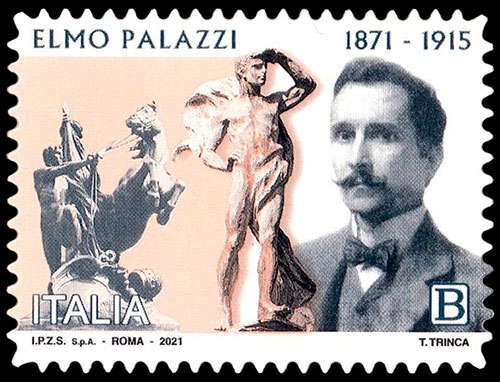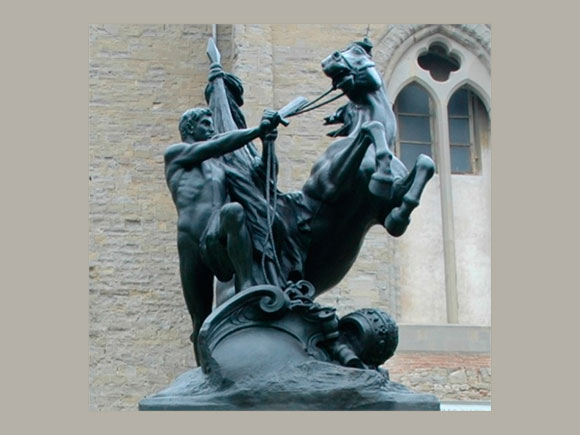
On December 23, 2021, the Italian Post issued a stamp in honor of the 150th anniversary of the birth of the Italian sculptor Elmo Palazzi.
Elmo Palazzi was born in Citta di Castello, Umbria in 1871. At the age of 17 he came to Florence, where he studied at the School of Decorative Arts. In 1895 Palazzi moved to Rome. To improve his skills in sculpture, he attended the workshop of the famous sculptor Ettore Ferrari. Cooperation with Ferrari gives Palazzi the opportunity to fully immerse himself in the artistic atmosphere of Rome of those years. Without neglecting the study of classicism and ancient sculpture, Elmo Palazzi begins to develop his own stylistic devices. Solemn scenes on historical themes are intertwined in the work of Palazzi with lighter motifs, which were imprinted by the emerging Art Nouveau. During this period, the young sculptor constantly participates in competitions and receives prizes for his works, which later became part of significant monumental works.
Among the most important works created by Palazzi are one of the four winged Victories from the sculptural group "Allegory of Victory" on the Vittorio Emanuele Bridge in Rome (1910-1911); "Allegory of Umbria" on the frieze of the grandiose monument to Vittorio Emanuele II, better known as the Vittoriano in Rome (1911); Monument September 11, 1860 in Citta di Castello (1914).
In 1903, Elmo Palazzi, for health reasons (he had a bad heart), ceased active work and returned to his homeland in Citta di Castello. There he continues to sculpt, carry out private orders, and is engaged in charitable activities. Elmo Palazzi died in 1915, at the age of 44, in a studio house he built on the ancient walls of Citta di Castello, skillfully combining architecture, sculpture and garden art.
On the commemorative postage stamp, designer Tiziana Trinca features a portrait of the sculptor by Luigi Casadio, as well as two iconic sculptures by Elmo Palazzi: The 9/11 Monument. 1860" and the Oriente sculpture. These works were chosen not only because they showcase Palazzi's talent and style, but also because they are both associated with his hometown, Citta di Castello. "Oriente" - a sandstone sculpture of a young man, adorns the outer corner of the sculptor's house, and the "September 11 Monument". 1860" installed in Piazza Raffaello Sanzio.

"September 11 Monument". 1860" dedicated to the liberation of Citta di Castello from Papal rule and its accession to the Kingdom of Italy on September 11, 1860.
The monument is located in the center of Piazza Raffaello Sanzio. In addition to commemorating the entry of Italian (Piedmontese) troops led by General Fanti into Citta di Castello and the subsequent annexation of the city to the Italian state, it is dedicated to the inhabitants of Citta di Castello who fell during the wars of independence.
The sculptural composition, consisting of the figure of a young warrior with a flag and a rearing horse, is full of deep allegorical meaning. The horse is the people of Citta di Castello, yearning for freedom from fetters and ready for rebellion. The young man who cuts the fetters with a sword that binds a horse to golden keys and a tiara - symbols of papal power - is the Piedmontese army that came to the aid of the inhabitants of Citta di Castello.
Work on the creation of the monument began in 1910, when the necessary funds were collected by a specially created committee. Elmo Palazzi agreed to work on this important project for free. Work on the monument was completed in August 1914, the grand opening of the monument took place on September 23, 2014. The monument caused a lot of controversy in Catholic circles, who considered it an insult to the Church, since the horse trampled on the symbols of papal authority. In the 1920s, the papal tiara was even removed from the monument for some time. Plaster models and casts of the monument, handed down by the sculptor's heirs, are kept in the Municipal Art Gallery of Citta di Castello.
The monument, created by Elmo Palazzi in his hometown, occupies a worthy place among the historical monuments dedicated to the events of the Risorgimento (the national movement of the Italian people in the middle of the 19th century - 1861 for the unification of fragmented Italy, against foreign rule).
Elmo Palazzi left a significant mark on the history of Italian art at the beginning of the 20th century, as evidenced by the issue of a commemorative postage stamp.
The presentation of the postage stamp took place in the Citta di Castello at the Bufalini School (of which Palazzi was one of the founders in 1909) in a solemn ceremony in the presence of the mayor of the city. In addition to the postage stamp, the Italian Post also prepared a first day cover, a maximum card and a special commemorative folder. On the day of issue, the stamps were canceled with a special postmark.
From this day on, the creations of Elmo Palazzi from Citta di Castello will travel around the world on a postage stamp.

Перейти в каталог
I apologize for any errors or inaccuracies


